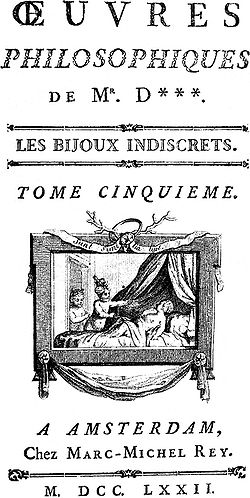 | |
| Author | Denis Diderot |
|---|---|
| Original title | Les Bijoux indiscrets |
| Language | French |
Publication date | 1748 |
| Publication place | France |
The Indiscreet Jewels (or The Indiscreet Toys, or The Talking Jewels; French : Les Bijoux indiscrets) is the first novel by Denis Diderot, published anonymously in 1748. It is an allegory that portrays Louis XV of France as Mangogul, Sultan of Congo, who owns a magic ring that makes women's vaginas ("jewels") talk. The character of Mirzoza represents Louis XV's mistress Madame de Pompadour. [1] Diderot portrayed Pompadour in a flattering light in The Indiscreet Jewels, most likely to ensure her support for his Encyclopedie. [2]